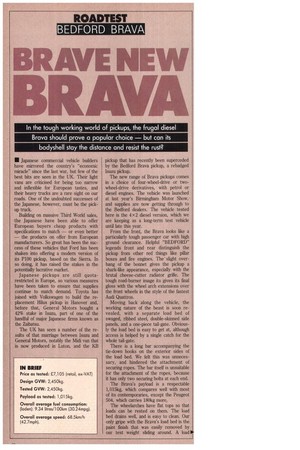BRAVE
Page 52

If you've noticed an error in this article please click here to report it so we can fix it.
;;YA,
/ Japanese commercial vehicle builders have mirrored the country's "economic miracle" since the last war, but few of the best bits are seen in the UK. Their light vans are criticised for being too narrow and inflexible for European tastes, and their heavy trucks are a rare sight on our roads. One of the undoubted successes of tlie Japanese, however, must be the pickup truck.
Building on massive Third World sales, the Japanese have been able to offer European buyers cheap products with specifications to match — or even better — the products on offer from European manufacturers. So great has been the success of these vehicles that Ford has been Si into offering a modern version of its P100 pickup, based on the Sierra. In si3 doing, it has raised the stakes in the potentially lucrative market.
Japanese pickups are still quotarestricted in Europe, so various measures have been taken to ensure that supplies continue to match demand. Toyota has joined with Volkswagen to build the replacement Wu pickup in Hanover and, before that, General Motors bought a 42% stake in Isuzu, part of one of the handful of major Japanese firms known as the Zaibatsu.
The UK has seen a number of the results of that marriage between Isuzu and General Motors, notably the Midi van that is now produced in Luton, and the KB pickup that has recently been superceded by the Bedford Brava pickup, a rebadged Isuzu pickup.
The new range of Brava pickups comes in a choice of four-wheel-drive or twowheel-drive derivatives, with petrol or diesel engines. The vehicle was launched at last year's Birmingham Motor Show, and supplies are now getting through to the Bedford dealers. The vehicle tested here is the 4x2 diesel version, which we are keeping as a long-term test vehicle until late this year.
From the front, the Brava looks like a particularly tough passenger car with high ground clearance. Helpful "BEDFORD" legends front and rear distinguish the pickup from other red things like pillar boxes and fire engines. The slight overhang of the bonnet gives the pickup a shark-like appearance, especially with the brutal cheese-cutter radiator grille. The tough road-burner image its given its final gloss with the wheel arch extensions over the front wheels in the style of the fastest Audi Quattros.
Moving back along the vehicle, the working nature of the beast is soon revealed, with a separate load bed of swaged, ribbed steel, double-skinned side panels, and a one-piece tail-gate. Obviously the load bed is easy to get at, although access is helped by a single catch for the whole tail-gate.
There is a long bar accompanying the tie-down hooks on the exterior sides of the load bed. We felt this was unnecessary, and hindered the attachment of securing ropes. The bar itself is unsuitable for the attachment of the ropes, because it has only two securing bolts at each end.
The Brava's payload is a respectable 1,015kg, which compares well with most of its contemporaries, except the Peugeot 504, which carries 180kg more..
The wheelarches have flat tops so that loads can be rested on them, The load bed drains well, and is easy to clean. Our only gripe with the Brava's load bed is the paint finish that was easily removed by our test weight sliding around. A load








































































































































